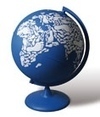Los
biólogos de mi generación no conocimos personalmente a Osvaldo Reig. Para
aquellos que comenzamos a cursar en la Facultad de Ciencias Exactas a finales
de la década del 90, Reig es un nombre en una placa de un aula. En ese sentido,
tan etéreo e inasible como “Amos”, “Leloir” o “Burkart” por nombrar otros
apellidos que custodian lugares de esta Facultad. Entonces, escribir sobre
Osvaldo no responde, en mi caso, a una admiración desarrollada por interacción
con su persona en vida o a querer preservar en escrito vivencias personales que
lo incluyen. Probablemente sea más bien una indagación sobre quien fue ese
científico cuya ausencia tiene tanto de reciente que genera esa incómoda idea
de que fue solo por poco que uno se perdió de conocer. Si hoy rescatamos este nombre
de una placa es porque tiene una vigencia innegable y es una cantera formidable
de conocimiento y principios para aprovechar, pero por sobre todo, por ser un
ejemplo de superación de dificultades. Una persona que siendo reconocida
mundialmente buscaba la legitimidad y el arraigo en su país.
Aquellos
que se adentran en el estudio de la zoología, paleontología o biología
evolutiva, tarde o temprano llegan a su obra. Su pensamiento enseguida rodea y
acompaña a aquellos que indagan sobre el desarrollo de la biología y
paleontología argentina del siglo XX.
Los aportes
científicos de Reig comenzaron muy tempranamente en su vida. La biblioteca
familiar tenía obras de Darwin y de Ameghino que Osvaldo no tardó en apreciar. De
adolescente fue un aficionado autodidacta de la Paleontología. En 1945, iba a
publicar junto con su amigo Jorge Kraglievich y con tan solo 16 años su primer
trabajo científico, una descripción de un carpincho fósil, en las Notas del
Museo de la Plata. Por la misma época era expulsado del Colegio Nacional Buenos
Aires por sus cuestionamientos al autoritarismo del gobierno local y el
fascismo europeo. Esta dinámica entre logros científicos y avatares políticos
será una constante que lo acompañará por el resto de sus días.
Reig comenzó los
estudios universitarios en 1950 en la Universidad de La Plata, pero no pudo
completarlos allí. Su militancia progresista le había significado maltratos,
persecuciones, cárcel y torturas. A los dos años se estaba yendo a Buenos Aires
a trabajar en el Museo Argentino Bernardino Rivadavia y retomar brevemente sus
estudios, ahora en la Universidad de Buenos Aires.
Su
crecimiento profesional continuará firme. En 1955 reporta un descubrimiento de
gran relevancia. Analizando la morfología dentaria y otras características
esqueletarias concluye que el marsupial conocido como Monito del Monte (Dromiciops australis), habitante de
nuestros bosques patagónicos, pertenecía al grupo de los microbiotéridos, descriptos por Florentino Ameghino y considerado un grupo
de mamíferos marsupiales extintos hacía millones de años. La Argentina tenía su
propio fósil viviente. Por otro lado, sus estudios sobre anuros fósiles del
género Nothobatrachus, de los más
antiguos conocidos en ese momento, le brinda un mayor prestigio internacional.
En 1957 es electo Presidente de la Asociación Paleontológica
Argentina. Esta consolidación de su reputación como
paleontólogo, lejos de anquilosarlo, lo lleva a ampliar sus investigaciones. Es
un convencido de que el estudio de los fósiles es incompleto si no incluye un
marco más amplio brindado por la biología evolutiva. Cuando en 1959 discute en
Holmbergia si la Paleontología pertenece al campo de la Biología o de la
Geología (él era un acérrimo defensor de lo primero) se encarga de aclarar que
no es una discusión meramente formal. Entendía que era un problema que debía
encararse ya que “de la adecuada
resolución de este litigio de pertenencia depende la médula racional, el
fundamento conceptual necesario para un adecuado planteo de los objetivos del
trabajo del investigador interesado por los organismos del pasado.” Años
más tarde definiría como enriquecedor y gratificante el “salto” de la
Paleontología hacia la Genética Evolutiva aunque lo percibió más bien como una
integración de enfoques: “exigida por la
propia dinámica de la maduración de mi indagación sobre los procesos evolutivos”
El otro aspecto
relevante para apreciar la obra de Reig es su faceta de fundador de grupos de
investigación. En 1958, con un cargo de Profesor en la Universidad de Tucumán
funda, en el Instituto Fundación Miguel Lillo,
el Laboratorio de Vertebrados Fósiles y en paralelo uno de herpetología. Organiza con Galileo Scaglia expediciones a
Ischigualasto, San Juan, con la colaboración de varios paleontólogos del país
entre los que se encontraba José Bonaparte que luego continuará con esa labor.
Estas expediciones ponen al Valle de la Luna en el mapa de la paleontología
mundial aportando valiosos datos sobre la fase temprana de la evolución de los
dinosaurios y preservando muchos especímenes de campañas norteamericanas a la
misma zona que sacaban del país a los fósiles encontrados.
En 1960 es contratado
por la Universidad de Buenos Aires y vuelve a la Facultad de Ciencias Exactas
como Profesor. Su trabajo en la FCEyN, en el Departamento de Ciencias
Biológicas, se centrará en estudios evolutivos de los mamíferos sudamericanos.
En 1961 gana por concurso un cargo de Profesor Titular a pesar de no contar con
un título de grado y gracias a sus evidentes méritos científicos (el famoso
paleontólogo George Gaylord Simpson formaba parte del jurado). En 1962 funda el
LIHUBA, Laboratorio de Investigaciones Herpetológicas de la Universidad de
Buenos Aires, y en 1963 comienza a coordinar el grupo de Biología Evolutiva de
Vertebrados en el Departamento de Ciencias Biológicas. La Genética y Ecología
de Poblaciones comienzan a ser el campo central de sus investigaciones.
No
estuvo ajeno a una de las etapas más tristes de la historia de la ciencia
argentina. Mientras se encontraba en una estadía de investigación en Harvard,
en nuestro país se desataba el golpe del 66 y la Noche de los Bastones Largos.
Osvaldo Reig renuncia a su cargo de profesor y deja todo su equipo atrás para
exiliarse en Venezuela. En la Universidad Central de Venezuela organizará el Grupo
de Evolución y Citogenética. También comenzara estudios en Chile donde organizará
y, de 1972 a 1973, será el director del Instituto de Genética y Evolución de la
Facultad de Ciencias de la Universidad Austral. Allí estudiaba a los ratones de
campo y los tuco-tucos.
Osvaldo
se doctoró en 1973 en Londres (Área de Zoología y Paleontología, Facultad de
Ciencias, University College of London) sin haber terminado una licenciatura en
su país natal.
Al regresar a Chile otra vez la
política atentará contra su trabajo. El presidente Allende es derrocado en un
golpe militar. El perfil de Reig, su militancia, lo pone en la mira del nuevo
gobierno. Es secuestrado y encarcelado y su vida realmente corre peligro. Solo
la presión y gestión internacional permite su liberación. Vuelve a la Argentina
y a la UBA con un cargo en la FCEyN pero nuestro país no es ajeno a la
turbulencia política y Osvaldo sentirá el hostigamiento también aquí. Estando
en un congreso en México se entera de que el rector interventor Ottalagano lo
había echado de la UBA. Ni siquiera regresa a Buenos Aires y vuela directamente
a Venezuela, donde es cordialmente recibido por sus colegas pero se enfrenta a
un nuevo exilio. Primero en la Universidad de Los Andes en Mérida y luego en la
Universidad Simón Bolívar de Caracas, Reig continuará con sus líneas de investigación.
Sus estudios en roedores y marsupiales sobre especiación y su correlato con la
evolución cromosómica cobran un gran desarrollo. Es uno de los científicos que
acompaña los replanteos a algunos postulados básicos de la Síntesis Moderna. Su
amistad con Mario Bunge y la enriquecedora influencia de la filósofa Estela
Santilli, su mujer y compañera en la vida itinerante, hicieron que siempre
fueran muy fuertes sus inquietudes epistemológicas. En uno de sus escritos
podemos leer de su propio puño: “Las preocupaciones epistemológicas, los
intentos de clasificación de las ciencias, deben valorarse como temas cuyo
desarrollo es altamente beneficioso y necesario para el desenvolvimiento de las
investigaciones; para encontrar sentido y objetivos a las tareas del científico
que, desvinculadas de los intentos interpretativos y de la correcta
delimitación de metas, pueden perder jerarquía y desvanecerse en el juego fácil
de lo rutinario, en las autosuficiencias de lo meramente analítico y
clasificatorio.”
Así Reig suma a su quehacer
paleontológico y genético la reflexión sobre los enfoques reduccionistas en la
biología evolutiva y sobre la realidad de las especies biológicas. Asimismo,
empieza a considerar a la variabilidad que se encuentra entre los individuos de
una misma especie como un tópico central para la comprensión de los fenómenos
evolutivos. Sus resultados iban a ser discutidos con los de las grandes figuras
de la biología evolutiva de esas décadas.
Por esos tiempos entiende que
necesita incorporar otro modelo más para terminar de complementar sus líneas de
investigación. Así el paleontólogo/mastozoólogo/herpetólogo incorpora a las
moscas del género Drosophila como
modelo genético evolutivo de sus investigaciones. Por sus características
biológicas, estos insectos le permitían la experimentación y puesta a prueba de
hipótesis sobre especiación y evolución como ningún otro de sus objetos de
estudio. Pero incluso con este modelo clásico tendrá una vuelta de tuerca. Las
especies de Drosophila que comienza a
estudiar son un grupo particular de moscas neotropicales especializadas en la
explotación de los cactus como medio de cría. En otras palabras, un modelo
genético clásico e internacional pero aggiornado
a problemáticas y eventos biológicos con interés regional.
Volverá
a nuestro país en 1983, luego del restablecimiento del orden democrático, como
miembro superior del Consejo Nacional de
Investigaciones Científicas y Técnicas (CONICET).
Originalmente regresa con un proyecto para hacerse cargo, reorganizar y modernizar el Museo Argentino
de Ciencias Naturales. Si bien cuenta con el apoyo de las autoridades
nacionales, algunos sectores conservadores y de la Iglesia Católica montan una
campaña mediática (algunos recuerdan a Magdalena Ruiz Guiñazu arengando
indignada desde su programa de radio) para que Reig no se instale en el Museo. Finalmente
estos sectores se impondrán y otro proyecto de Reig quedará trunco.
La
consolidación de tiempos democráticos no significa el cese de la hostilidad por
parte de otros colegas. Se instalará finalmente en la facultad de Ciencias
Exactas y Naturales de la UBA, donde organiza el Grupo de Investigación en
Biología Evolutiva (GIBE) para continuar con sus investigaciones en genética y
ecología evolutiva. Los estudios incluirán sus diversos modelos animales, desde
tuco-tucos y primates neotropicales hasta las moscas del género Drosophila. Aquí también, quizás por
representar vientos de cambio, tendrá que confrontar y sufrir la interacción
con los resabios académicos que sobrevivieron los años oscuros del
Proceso.
1986
resulta un año que delinea de manera muy interesante lo que fue parte de su
vida. En un mundo bipolar, ordenado por las tensiones de la Guerra Fría, se
puede decir que todos los bloques involuntariamente consensuan reconocer la
carrera de Reig de manera simultánea. La Academia de Ciencias de la Unión
Soviética lo nombra Miembro Honorario mientras que la Academia Nacional de
Ciencias de Estados Unidos lo acepta como Miembro Asociado Extranjero. Como si
fuera poco, la Academia de Ciencias del Tercer Mundo también lo nombrará
miembro. Triple reconocimiento en un mundo dividido.
La
cosecha de reconocimientos continuará. En 1989 la Universidad Autónoma de
Barcelona le otorga el título de Doctor Honoris Causa y la Universidad de
Buenos Aires lo hará en 1991. Un año después la Universidad Simón Bolívar lo
nombrará Profesor Honorario.
Algunos
pasajes de su discurso de aceptación del título en la Universidad de Barcelona
son fieles resúmenes de cuáles fueron sus motivaciones y principios durante su
carrera científica:
“Ahora está claro que la comprensión de los
procesos evolutivos presupone la ampliación permanente del contexto teórico y
el trabajo multidisciplinario y en equipo. Eso exige deponer la adhesión a
cotos de investigación excluyentes. (…) Habrá siempre quienes se resientan a
abandonar los privilegios que presupone practicar una disciplina que pretende
ser autosuficiente. Siempre existirán los que traten de explicar mucho con lo
poco que saben. El verdadero científico será siempre, empero, aquel que
reconoce los límites de su saber, y que sabe convocar el conocimiento ajeno. (…)
No hay nada más distante de los enunciados de la ciencia que las afirmaciones
apodícticas de certeza, ni nada más contradictorio con la actitud científica
que el fundamentalismo y el infabilismo.”
Osvaldo
Reig fue un biólogo evolutivo que hizo ciencia de calidad en los contextos más
adversos que podemos imaginar. Exiliado y perseguido, su éxodo dejó un
semillero de laboratorios y grupos de trabajo en la Patria Grande. Las
condiciones políticas lo expulsaron dos veces de nuestra Facultad pero terminó
establecido en ella, trabajando a la vanguardia de la biología evolutiva. Su
legado está en todos lados.
Hoy,
a más de 20 años de planteadas, los laboratorios del GIBE y de Evolución en el
Departamento de Ecología, Genética y Evolución continúan respondiendo,
desarrollando y ampliando las preguntas de Osvaldo sobre especiación, genética
y ecología evolutiva. Osvaldo Reig estableció el dictado de Evolución,
Macroevolución y, junto a la Dra Ana Báez, Sistemática Teórica en la carrera de
Biología. Siempre consideró que Evolución debía ser una materia básica de la
carrera. Algunos de sus becarios y tesistas son ahora investigadores y
profesores de esta Facultad y sus ex alumnos son aún más numerosos. Para
muestra basta un botón. El Dr. Hernán Dopazo volvió al país el año pasado y
ahora dirige el Laboratorio de Genómica Biomédica y Evolución en el
Departamento de Ecología, Genética y Evolución. Hernán hizo su tesina de
licenciatura en el GIBE de Reig y fue ayudante en sus materias. Consultado
sobre sus experiencias directas con su mentor rescata el privilegio que le
significó las charlas que entablaban de regreso a sus hogares después de dar
clase. Lo considera un maestro porque generaba y transmitía rigor de
pensamiento en quienes formó. “Era un gigante”- explica Hernán- “No volví a
encontrar una persona así en todos los años de carrera que hice”.
Nunca
se quedó quieto, nunca se “acomodó” en un tema. No hizo la plancha. No se
conformó. Hace 20 años moría Osvaldo Reig.
Este 14 de agosto hubiera cumplido 83 años. Nos deja mucho más que Ischigualasto,
el Monito del Monte como fósil viviente, Nothobatrachus,
dinosaurios, la biología evolutiva argentina hermanada a su paleontología,
ideas sobre el origen de las especies, reflexiones sobre el cómo hacer ciencia
y como no hacerla, sobre el despotismo y el abuso del poder, líneas de
investigación, decenas de investigadores formados y un ejemplo de compromiso
real con las convicciones personales. Sus
campos fueron la paleontología, la biología evolutiva, la genética, la
sistemática y la biogeografía. Pero con una
producción académica de excelencia sus aportes más valiosos quizás no se puedan
buscar en papers. El autodenominado
“biólogo itinerante” nos dejó una hoja de ruta formidable. Admirador de
Ameghino y trabajador incansable, trasmitió la importancia del rigor en cada
aspecto de la construcción del conocimiento.
A
veces las placas guardan nombres ilustres que trasmiten solemnidad y respeto. A
veces no mucho más que eso. Pero cada tanto, el bronce atrapa aunque sea el
nombre de gente infatigable, buscadores de verdades, de fósiles, ratones o
moscas. Esa gente que años más tarde, a quienes no lo conocimos, todavía nos da
la sensación de que nos lo perdimos por poco.
Agradecimientos:
Quiero
agradecer al Dr Hernán Dopazo y al Dr. Esteban Hasson por facilitarme
experiencias y anécdotas y al Dr. Raúl Gómez por las contribuciones
bibliográficas.
Bibliografía
consultada (y recomendada para profundizar el tema):
Quintana
C.A. 2012. Conociendo a nuestros científicos. Osvaldo Alfredo Reig. Pp 42.
Ediciones ULP, Argentina.
Reig,
OA. 1959. Acerca de la ubicación de los estudios paleontológicos. Holmbergia 15(4):19-45
Reig,
OA. 1989. Doctor Honoris Causa. Discurso leído en la ceremonia de investidura.
Facultad de Ciencias, Universidad de Barcelona. Bellaterra.




